
The exclamation point at the end of this post’s title is a little gimmicky, I know. But if there were ever a time to use an exclamation point in a post title, this is it. As soon as I saw this post at The Kitchn about making homemade pasta in the food processor, I was curious. As any Italian grandma would tell you, pasta-making traditionally involves very specific rules, from the mounding of the flour on the counter to the setting the eggs in the center to the incorporating everything into a workable dough. If the process could actually be as simple as a few minutes in a food processor, why wasn’t everyone doing it that way? Was this a gimmick or a trick? I’ll admit I was skeptical, but since The Kitchn rarely steers me wrong, regularly pointing me to such interesting resources as a simple sourdough starter, cool kitchen designs and a reminder about a Samoa popcorn recipe I have got to try, I figured this concept was worth a shot. That very day I saw the piece, I pinned the article, scrolled through the how-to guide and told Tim I wanted to try it with einkorn flour, that ingredient we’re always talking about here and that people say is especially wonderful when used in homemade pasta dough.
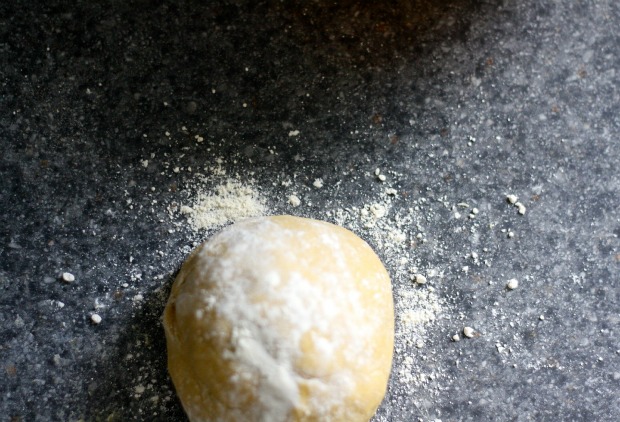
We penciled homemade pasta in our meal-planning notebook a week ahead of time, saving it for a Saturday afternoon when we’d have a few free hours to devote to the process. I went out for brunch, we worked at a coffee shop and, when we came back, while I whirred ingredients in the food processor (big success!), Tim climbed up on a chair to reach the cabinet above the fridge where his pasta maker hides.
Tim got his pasta maker from his grandma, Emily, that sweet, smiling woman you’ll remember from our Italian green beans recipe. He’s used it before, most notably for a certain dinner of homemade ravioli he surprised me with once a few years ago (on a day when, please note, I was in the midst of very carefully trying to surprise him). I’ve made ravioli before, too, but never with a pasta maker to stretch out the dough.
So Saturday marked the first-ever time the two of us made pasta dough together.
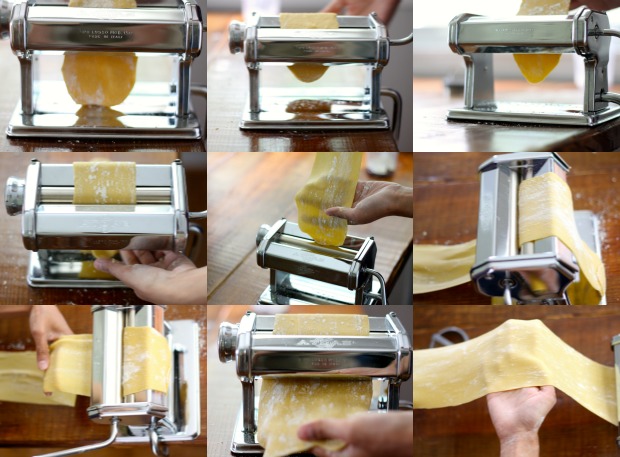
Tim secured the machine on the table, saying “This table is perfect for this!” Next, he turned the dial to “1” and demonstrated how to move a fourth of our resting dough through the machine, cranking with one hand, holding the dough with the other. Soon I was participating. As I watched sheet after sheet of dough elongate and thin before my eyes, I kept exclaiming, “This is so fun!” to which Tim would laugh and say, “It is?”
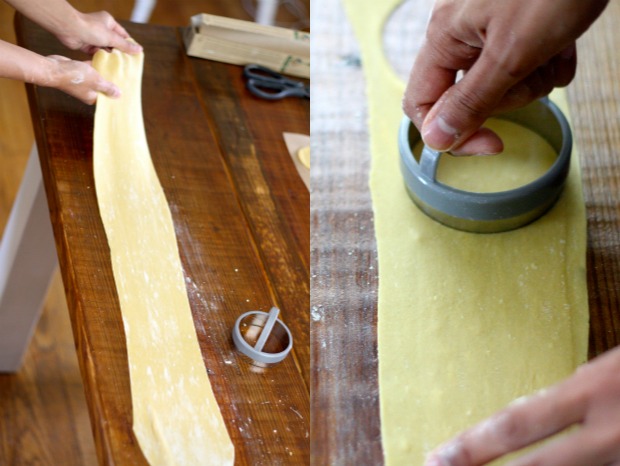
We cut the strips of dough into rounds and squares for ravioli, dolloping filling in the centers, brushing the ridges with water and layering matching sizes on top. The dough was so elastic, so everything you’d hope for in pasta dough, that I’m officially convinced einkorn is the way to go.

For the stuffing, we combined ricotta, sundried tomatoes and capers, and the combination made every bite pop. Honestly though, when it comes to ravioli, I’m not picky—even plain ricotta would be good.
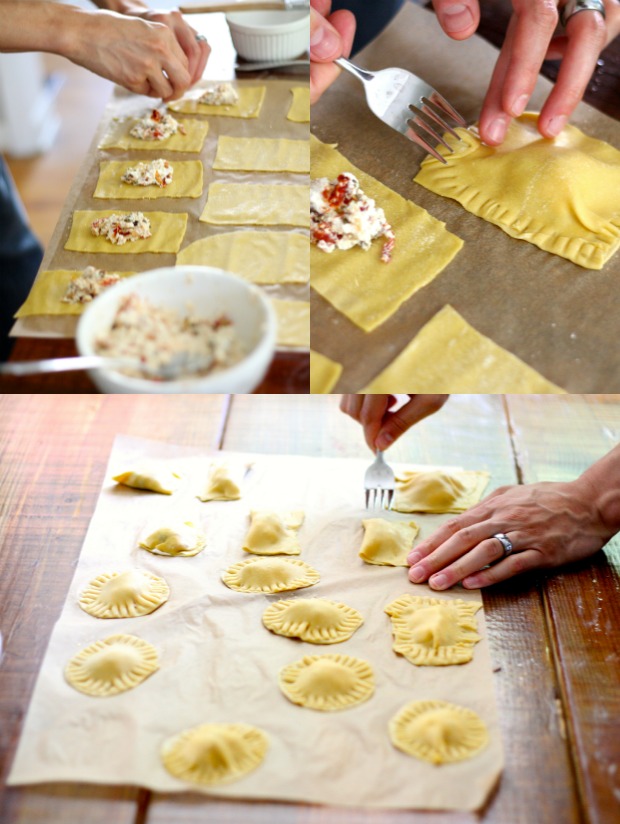
Thanks to the food processor, the entire pasta-making process probably took two hours, total, from mixing dough to eating ravioli on our plates. And beyond being a fun kitchen project, it was something of a revelation, particularly done this way.


The first time I made ravioli, I told Tim, it would probably be a while before I did it again.
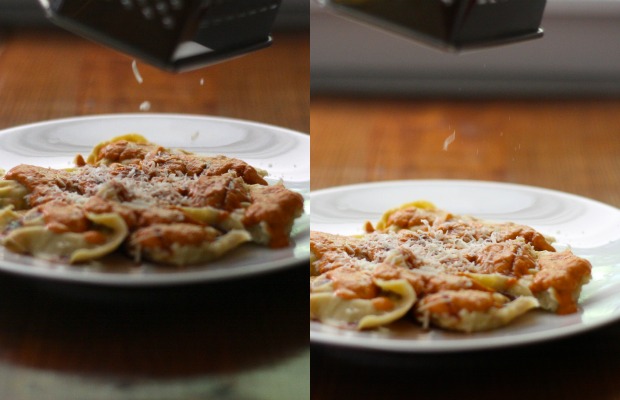
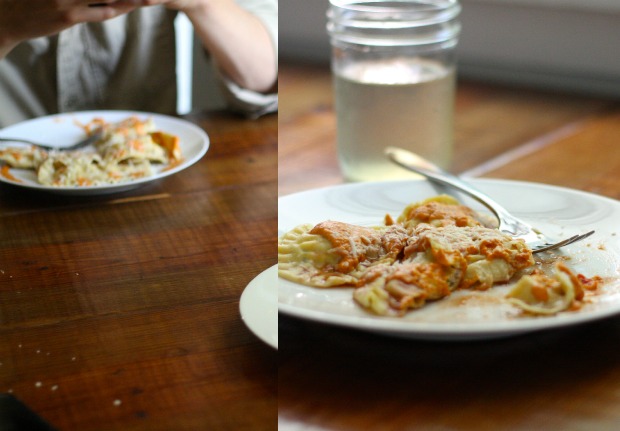
This last time, I couldn’t wait for the next opportunity.
Homemade Einkorn Ravioli with Sundried Tomato, Capers and Ricotta
Makes two to three dozen ravioli (dependent on the size you cut)
Not to be all salesy, but if you don’t have a food processor already, it’s a smart investment. We use ours all the time—to rice cauliflower, to grind up nuts for pestos, to, aha!, whip up pasta dough!
Ingredients:
for the pasta dough
2 to 3 cups einkorn flour (or your favorite basic flour)
1/2 teaspoon salt
3 eggs
for the filling
Olive oil
2 ounces sundried tomatoes
1 1/2 tablespoons capers
1 small onion, diced
1 tablespoon balsamic vinegar
16 ounces ricotta cheese
Directions:
Start by making the pasta:
In a food processor, combine the flour and salt. Pulse a few times to combine.
Add the eggs, cracking them right on top of the flour mixture. Return the lid to the top and process the mixture for 30 to 60 seconds. Stop when the dough comes together into a rough ball.
Take a look at the dough. If it’s dry, add a little bit of water. If it’s wet/sticky and is smearing against the side, add some flour. Repeat until the dough comes together.
Knead the dough into a smooth ball. Take it out of the food processor and knead it against the counter a few times until it is a smooth ball. Dust the dough with a little flour and place it in a bowl. Cover, and let it rest at room temperature for 30 minutes.
Make the filling:
In a medium skillet, drizzle some olive oil and warm it over medium heat. Add capers, sundried tomatoes, and onion; sauté until soft. In a medium bowl, combine all of the filling ingredients. Set aside.
Form raviolis:
Thin out and stretch out the dough, working with one quarter of the dough at a time; you may do this with a pasta machine, as pictured above, or by hand, via rolling the dough and cutting out circles or squares.
Place a dollop of filling in half the ravioli pieces; brush the edges with water; layer an empty ravioli piece atop each one; press down the edges and press with a fork, if desired.
Cook the ravioli:
Boil water in a big pot on the stove. Cook the ravioli for four or five minutes. At that point, take one out and taste it to see if it’s done. You may have to do this in batches.
*Note: Uncooked ravioli may be frozen on parchment, then moved to plastic bags to be frozen for later use.
About Shanna Mallon
Shanna Mallon is a freelance writer who holds an MA in writing from DePaul University. Her work has been featured in a variety of media outlets, including The Kitchn, Better Homes & Gardens, Taste of Home, Houzz.com, Foodista, Entrepreneur, and Ragan PR. In 2014, she co-authored The Einkorn Cookbook with her husband, Tim. Today, you can find her digging into food topics and celebrating the everyday grace of eating on her blog, Go Eat Your Bread with Joy. Shanna lives in Nashville, Tennessee, with Tim and their two small kids.

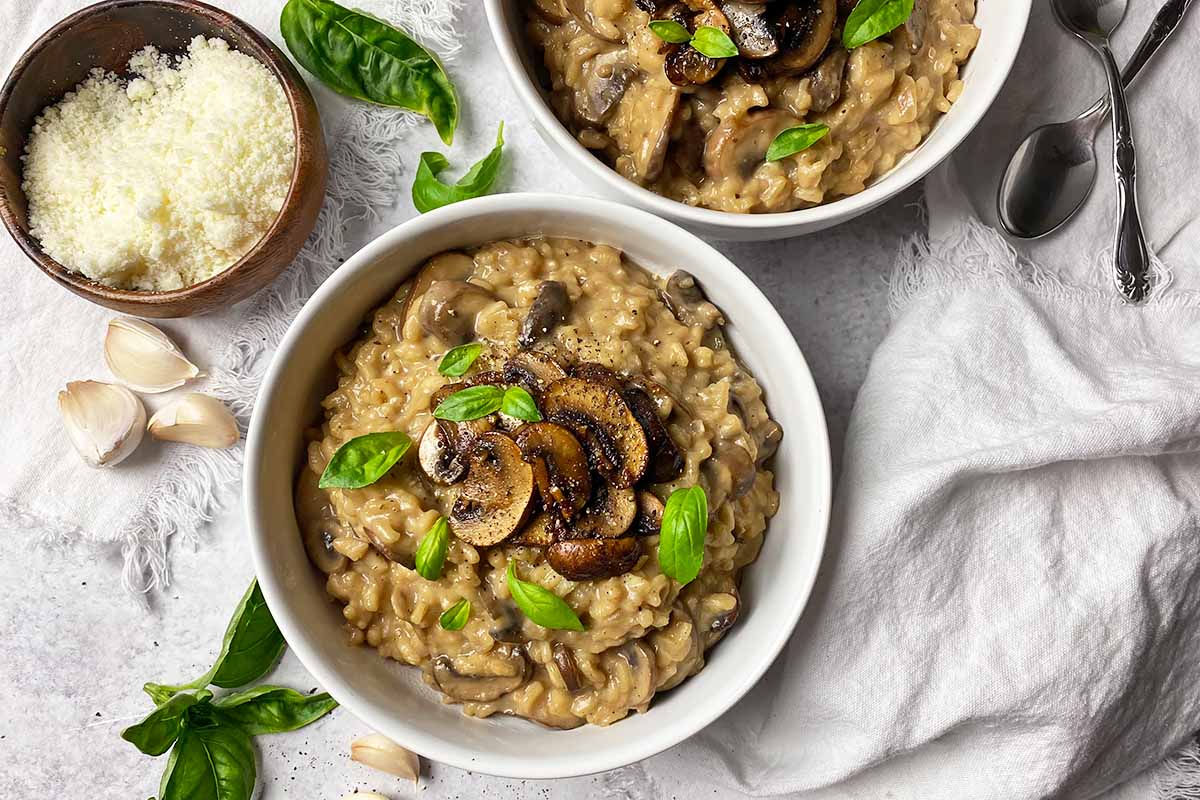
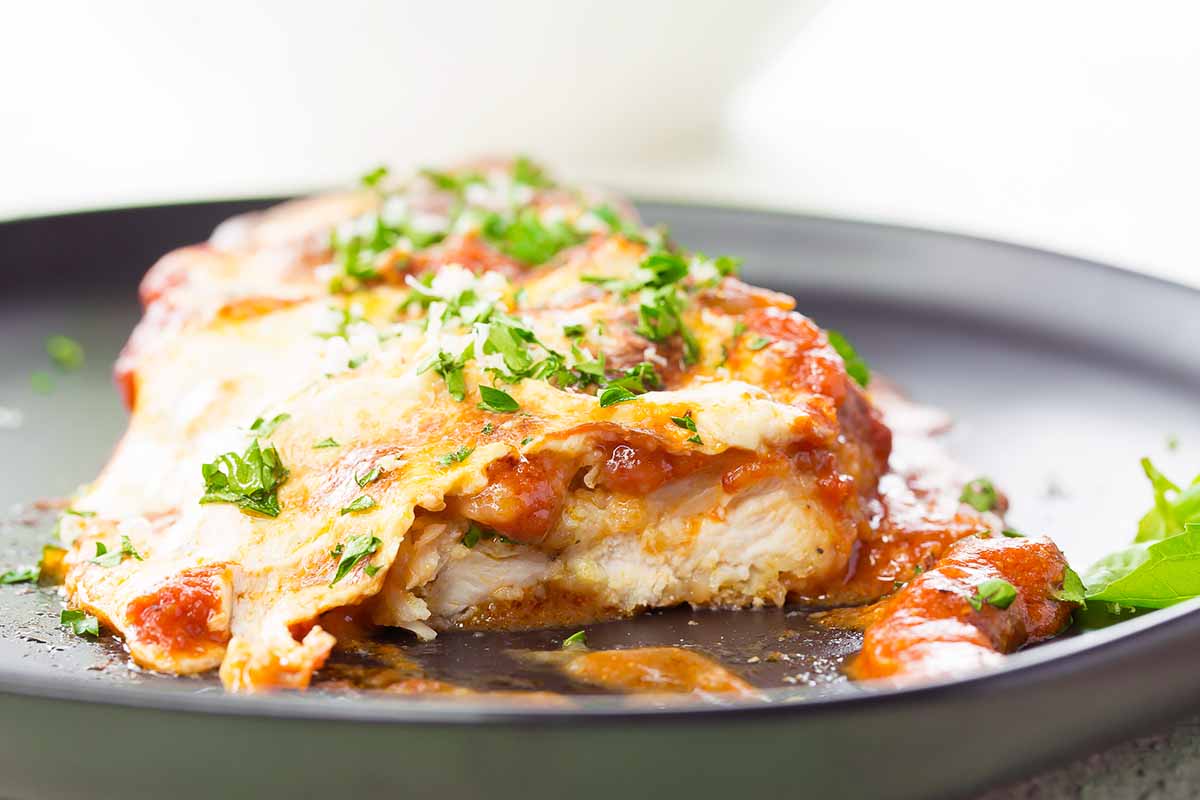
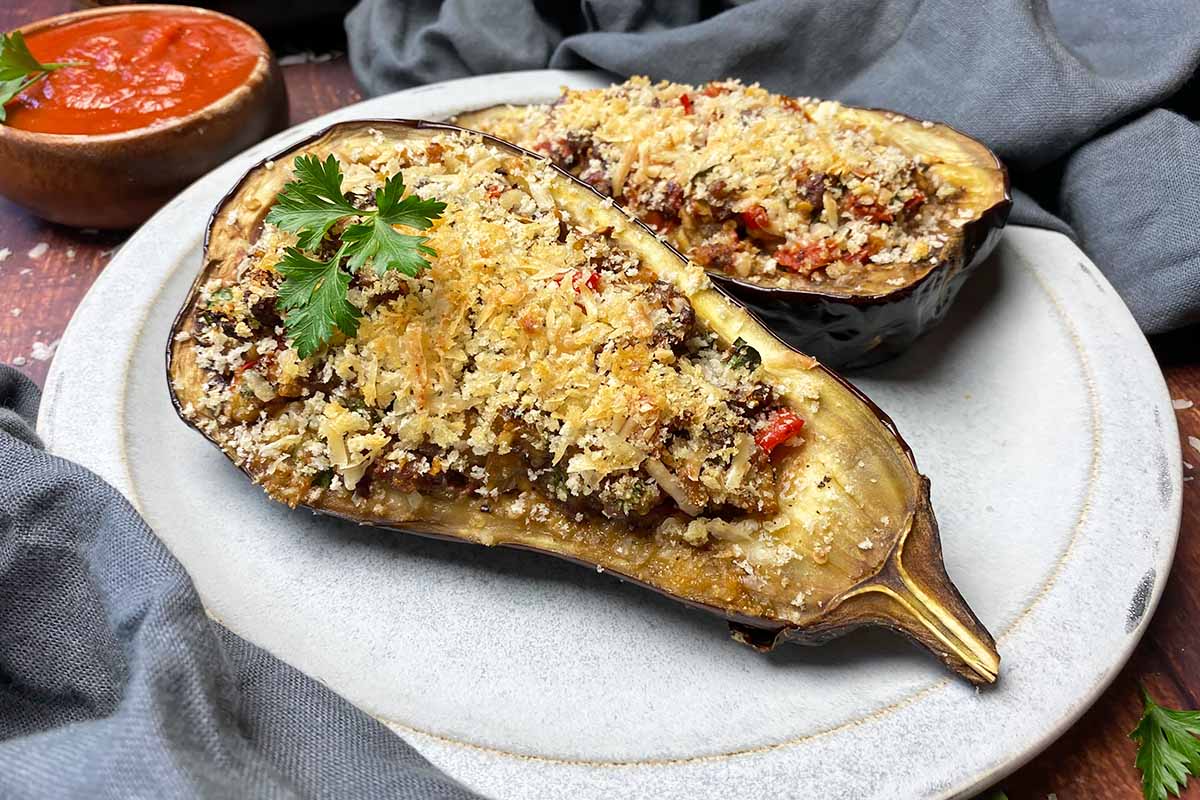
I would never have thought of pasta in a food processor but it really looks wonderful and silky smooth. Excellent choice of filling too.
Thanks, friend!
I’ve added a pasta maker to my christmas list this year (I know…a little ahead), but now I’m thinking that perhaps I don’t want to wait that long!
Ha! Erin, I’m telling you, I loved it so much. When you get one, you’ll have to let me know what you think!
This is awesome, Shanna! Such a fun Saturday night project. I have the pasta maker attachment for my KitchenAid, but have yet to try it out. This is making me think I need to break it out!
Oh, I’d love to see a post about that, Marie! Someone just asked me about the KitchenAid attachment, and I had to say I don’t know anything about it.
Pasta in a food processor? Hmmm, even I could probably do that! lol Thanks so much for sharing, Shanna, this recipe looks delicious!
I hope you will link up this wonderful recipe and others at my Foodie Friday Blog Hop at A Room for Two with a View. I know my readers would love it!
Have a fantastic Foodie Friday and a wonderful weekend!
Melissa
You’re so welcome, Melissa! Hope you had a wonderful weekend!
Hey shanna, another stunner recipe! I’ve made homemade tagiatelle before, but not in a food processor cos I don’t have one. I did it the old-fashion hand kneading, mount-dough-on-table style. And since then I’ve sort of left my pasta machine to collect dust. Now… I should really take on ravioli too! 🙂 enjoy your weekend with Tim!
Big hug, f.
Felicia, you know, I think there’s something to be said for making pasta the old-fashioned, dough-on-table way, if only to give us respect for all the work people have been doing for generations to make homemade pasta. Love that you’ve tried it, too!
I can hardly wait to make this!!!!
I hope you do, Linda! It’s a lot of fun.
Love, love,love this. I would never dream of making pasta in a food processor- but since it’s such a pain at times to get the dough just right, I may have to give it a go. Your photos are super cute – love the ravioli spread out all along the table! It’s just how I would imagine those sweet Italian Grandma’s got their raviolis pressed, too 🙂
Thank you so much, Ruthy!
This looks like a lovely way to spend an afternoon with the one you love!!
Hi! Just wanted to ask you what kind of einkorn flour did you use. Was it whole grain or something lighter? Thanks!
Maria, We used all-purpose einkorn flour. Good luck!
Thanks for the quick reply! Where do you get it? I always make pasta at home, but so far I only used the regular all-purpose wheat flour. I have whole grain einkorn flour, but only used it for bread. Thanks again!
Sure, Maria! We’ve been really happy with the einkorn we’ve bought via JovialFoods.com. Where have you bought the whole grain einkorn? We’ve yet to see it!
I just want to say – THANK YOU! I have been searching high and low for an Einkorn pasta dough recipe and all I keep finding is the premade dry stuff from Jovial. I’m sure its lovely but I wanted to try my own. Thanks again for this recipe.
Hey Shauna, yesterday I made a batch of einkorn pappardelle and left it out overnight to dry out. However, when I went to check on it this morning it had dried perfectly, but was also darkened in color. I don’t understand what may have caused this because, when I first made the pasta it was the regular color of einkorn pasta.
Hi Juanita, Since we didn’t try drying ours overnight, I’m not sure. I would guess it oxidized from the air exposure overnight; I wonder if the best way to do it might be in a dehydrator? These are just guesses. Good luck!
“Einkorn flour contains carotenoids that can oxidize if exposed to water and light for a long period of time. Just like a carrot peel can darken, einkorn dough will when exposed to light. Therefore, either store the bowl in a dark space or use a ceramic bowl and put a plate on top to protect the dough from light.” from the Jovial website
Hi Shanna,
Could this same recipe be used to make string pasta or do you recommend a different one.
Hi Allison, Yes! We have used this same basic recipe for einkorn noodles with excellent results, so I’d imagine it would work well in various pasta forms. Good luck — If you try it, please come back and tell us how it went!
Shanna, this recipe works great for string pasta too. My sister just sent me a pasta machine and I was wondering if Einkorn flour would work— using your recipe it works beautifully with Jovial’s Einkorn flour which I buy by the 10 lb bag!
Aw, Carolyn, I’m so glad to hear that! And we buy the big bag, too. ; )
Wow!!! Thank you for this blog. It’s very helpful.